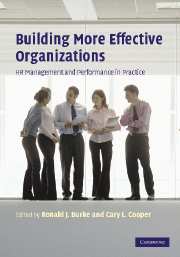Book contents
- Frontmatter
- Contents
- List of figures
- List of tables
- List of contributors
- Foreword
- Preface
- Acknowledgements
- Part I Building more effective organizations
- 1 Building more effective organizations: A primer
- Part II Enhancing individual health and performance
- Part III Enhancing organizational health and performance
- Part IV Transforming organizations
- Index
1 - Building more effective organizations: A primer
Published online by Cambridge University Press: 05 June 2012
- Frontmatter
- Contents
- List of figures
- List of tables
- List of contributors
- Foreword
- Preface
- Acknowledgements
- Part I Building more effective organizations
- 1 Building more effective organizations: A primer
- Part II Enhancing individual health and performance
- Part III Enhancing organizational health and performance
- Part IV Transforming organizations
- Index
Summary
This chapter sets the stage for those that follow. We seem to be at a “tipping point” (Burke and Cooper, 2006) in the way organizational leaders are coming to view the importance of people as a key element in their organization's success and are prepared to act on this realization. It first lays out new challenges facing organizations as their employees, competition and business environment changes. In response to these new, and in some cases continuing demands, organizations need involved and engaged employees, need to manage and develop their talent, and to continuously adapt and change to survive. Contributions from some central researchers and writers are thus reviewed to provide a sense of what is known about continued high levels of organizational performance and the emerging consensus of what needs to be done to achieve this.
The new world of work and organization
O'Toole and Lawler (2006), in collaboration with the Society for Human Resource Management, wrote a follow-up to Work in America, published in 1973. Using focus groups with HR managers and state-of the art reviews by leading US academics, they identify ways in which workplaces have changed over this time period, why these changes have occurred, the impact of these changes on workers and organizations, and organizational and government policy initiatives necessary for organizations (and American society) to remain competitive. Effective HRM that emphasizes building human capital lie at the center of these efforts.
- Type
- Chapter
- Information
- Building More Effective OrganizationsHR Management and Performance in Practice, pp. 3 - 32Publisher: Cambridge University PressPrint publication year: 2007



